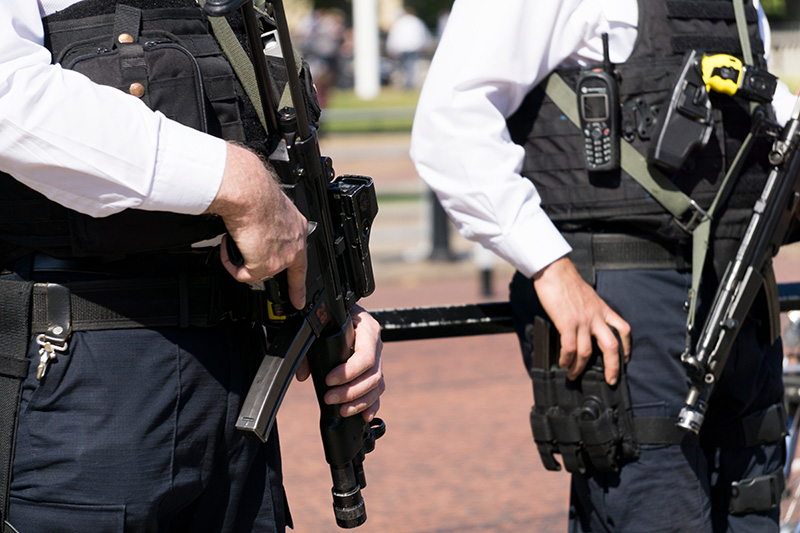Hundreds of London’s Metropolitan Police officers temporarily turned in their firearms in September after the Crown Prosecution Service charged an officer with the murder of unarmed 24-year-old Chris Kaba.
Up to 300 of the force’s 2,500 armed officers stepped back from their duties, leading the Met to request backup support from the army. Met Commissioner Sir Mark Rowley suggested that officers were concerned about having “sufficient legal protection to enable them to do their job”.
All is not well within these special squads, which have suffered from issues even before this shooting, and, as we found, are viewed as ‘macho’ and exclusionary by their unarmed colleagues.
Police shootings are rare, and rarer still are prosecutions. There have been only a handful of murder and manslaughter charges for officers following deaths in police custody, and just one has led to a successful prosecution.
Firearms officers are a voluntary role, and in recent years, forces have been struggling to fill their ranks. In a newly published report for the National Police Chiefs’ Council (NPCC), my colleagues and I found that a high number of officers felt “scrutiny following a police shooting” was the greatest barrier to them being recruited to a firearms squad.
But all is not well within these special squads, which have suffered from issues even before this shooting, and, as we found, are viewed as “macho” and exclusionary by their unarmed colleagues.
In her review of the Met police, Baroness Louise Casey found that some of the most toxic behaviour and misconduct was found in specialist firearms units. She described the Met’s firearms team as “well resourced, with elitist attitudes and toxic cultures of bullying, racism, sexism and ableism,” and a place where “normal rules do not seem to apply”.
While Casey’s evaluation was underway in London, the NPCC tasked my colleagues and I with examining the national picture. It was concerned that firearms units were struggling to recruit and retain staff, particularly women and members of minority groups.
“We know that there is a negative image and culture around being a firearms officer which is very male dominated,” said Simon Chesterman, the NPCC lead for armed policing. “Whilst this report makes difficult reading, it was essential for us to commission the independent research so that we can address the issues in order to … make armed policing more reflective of the communities we serve.”
The ‘toxic culture’ of firearms units
We surveyed more than 4,000 officers (38% of whom were current or former firearms officers and 62% of whom were not – and never had been – employed in the role), the survey revealed an ‘us and them’ divide between armed officers and the rest of the workforce.
Respondents described ineffective leadership and hyper masculine cultures perpetuated by sexist, ‘old school’ training regimes that filtered out those who might challenge the norms established by the dominant group.
Firearms officers described a “toxic culture” and a “jerk mentality” in their departments that serve consistently to privilege the dominant group: white men.
Others told researchers about their departments’ sub-optimal retention policies and processes that called into question the value the service places on officers. Several female ex-firearms officers who had left the units said that no efforts were made to keep them. And without a robust exit interview process in place, effectively, they were allowed to slip away without causing a ripple in the armed policing pond.
Casey found that those tasked with training and assessing firearms officers “further embed” a toxic and discriminatory culture by selecting officers “in their own image” and keeping out those “whose faces don’t fit their ideal of a firearms officer”. In practice, this means women and ethnic minorities.
Some of our armed respondents reported a similar dynamic. They described ineffective leadership and hyper masculine cultures perpetuated by sexist, “old school” training regimes that filtered out those who might challenge the norms established by the dominant group.
Why don’t people join?
Many of Casey’s respondents considered the firearms department “prestigious” and “elite”. That is unsurprising. Its officers are issued with better equipment, and they are better trained and supported. Yet, for all that – maybe because of that – they do not seem to have the respect of those colleagues who aren’t on the team.
Some of our respondents who are part of firearms teams reported positives to the organisational culture, such as the camaraderie and teamwork. They said that the firearms culture helps officers sustain their morale and sense of mission despite the rigours and risks of the work.
This study and the Casey review present an alarming picture. They raise important questions about the armed policing demographic, its ways of working, and the true appeal of the role to those who join a service committed to the principle of policing by consent.
Still, some insiders believe the culture privileges traditional forms of masculinity to such a degree that the needs of anyone outside of the dominant group are discounted. The survey showed that the needs of women officers are not always given the same priority as men – for example, female officers were often equipped with hand-me-downs of male kit that did not fit properly.
Some unarmed respondents said the “macho” culture of firearms teams was a disincentive to taking up arms. Around half of the unarmed officers in our sample who are qualified for the role said they would not consider joining them to perform it. Some said they were unfit or were unwilling to commit to the level of fitness required to perform the role. Some simply preferred other career options.
A significant number of unarmed respondents said they would consider the role only because they believed it offered them an escape from the pressures of operational policing. Some were disdainful of armed officers who, they said, avoid many of the duties and responsibilities routinely associated with the day-to-day business of policing.
That outlook was typified by one respondent who remarked dismissively that firearms officers could instead spend lots of time, “eating chicken at Nando’s and talking about tattoos”.
Taken together, this study and the Casey review present an alarming picture. They raise important questions about the armed policing demographic, its ways of working, and the true appeal of the role to those who join a service committed to the principle of policing by consent.
Arguably, the existing culture leads to division among the police ranks and is a significant barrier to departments’ affinity with the communities they serve. And ultimately, it is a threat to their legitimacy.
This article first appeared on The Conversation, and is republished under a Creative Commons Licence; the original can be read here.
About the Author
 Former Scotland Yard detective Dr Adrian James is Research Director at the Centre for Advanced Police Studies, Liverpool John Moores University, and a Reader in Police Studies. During his police career he led operational detective teams for the UK’s regional and national crime squads, and was intelligence manager in the Met’s aviation security (now counter-terrorism) and specialist crime commands. He was awarded his doctorate by the LSE for a study into the origins and development of intelligence-led policing, and has completed research for the College of Policing, the NPCC, and the Home Office.
Former Scotland Yard detective Dr Adrian James is Research Director at the Centre for Advanced Police Studies, Liverpool John Moores University, and a Reader in Police Studies. During his police career he led operational detective teams for the UK’s regional and national crime squads, and was intelligence manager in the Met’s aviation security (now counter-terrorism) and specialist crime commands. He was awarded his doctorate by the LSE for a study into the origins and development of intelligence-led policing, and has completed research for the College of Policing, the NPCC, and the Home Office.
Picture © Ink Drop / Shutterstock


